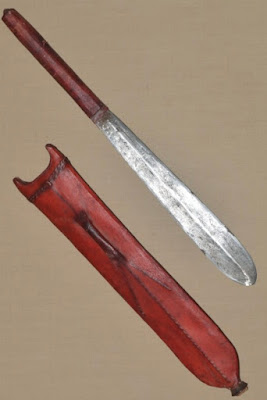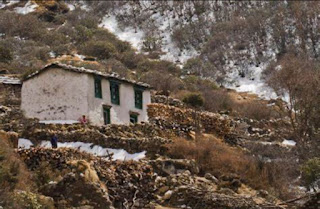This is the story of our serendipitous meeting with the Brais family - Marianne, Luigi, Peter and Micky - in London, 1974. We have remained the closest of friends to this day, visiting and corresponding across the miles for almost 50 years.
The story begins, as unlikely as it might seem, in the tiny village of Moyale in northern Kenya. Moyale actually straddles the border between Kenya and Ethiopia. At the time, Penny, Candice and I were hitch-hiking from Nairobi, Kenya through Ethiopia, Sudan and Egypt to the city of Aden, before flying to England. Such a trip these days would be rather more dangerous, given the instability and perpetual conflicts in the region. In 1974 there were dangerous elements to the journey, but we weighed the odds and, armed with the invincibility of youth, we plunged in.
By the time we reached Moyale, we had already endured one of the most dangerous rides of our hitch hiking years. After overnighting at the outskirts of a dusty village about half way from Nairobi to the northern boarder and waiting hours for a ride, we were finally picked up by a Sikh man driving a Volvo. He claimed to have competed in the famous East Africa Rally, but his erratic driving eventually led me to ask him to stop and let us out in the middle of nowhere. Only then did he slow down and drive a bit more responsibly.
The main cause of his bad driving was the distraction of the two beautiful sisters in the back seat. Each time Penny or Candice made a comment, he would turn to make eye contact and contribute to the conversation, completely ignoring the dangerous gravel road ahead. Each time this happened, I would turn from the front passenger seat and glare or frown at Penny and Candice in an attempt to stop them distracting our driver. They would return my glare with a puzzled expression, oblivious to the problem.
Our driver was actually travelling to collect his wife, girl friend and family who had been injured in an accident a few days previously. As we approached the village where his family was hospitalized, we passed the wreck of his Land Rover, which he had rolled over and written off. We actually visited his girlfriend in hospital, an attractive young English woman who’s pretty face had been badly cut up in the accident. We didn’t get into the details of his ménage a trios!
We eventually arrived in Moyale and made our way to the border, only to learn that the weekly bus to Addis Ababa, the capital of Ethiopia, had left an hour earlier. Rather than cross the border and wait a week on the Ethiopian side, we decided to look for a place to stay on the Kenyan side. We discovered a Catholic mission on the outskirts of the village and asked the priest if we might pitch our tents in the adjoining gardens.
Father Antonio was an Italian priest who had devoted his life to the spiritual, social and health needs of the surrounding African communities. By the time we met him in 1974 he had established an amazing bond of trust with the local people, who knew that they could approach him on any subject and secure his help and support.
The nuns who normally lived and served at the mission were away at a gathering elsewhere, so instead of pitching our tents on the mission grounds, Father Antonio invited us to move into their quarters for the week. After days of dusty and dangerous hitch hiking, we luxuriated in the peace of the spotless mission residence and gardens.
Father Antonio tended to his widespread flock in a rugged Land Rover, at that time the vehicle of choice for anyone navigating the African wilderness through the ever changing seasonal conditions. Over the course of the week, he invited us to join him on several visits to outlying settlements and bush camps - some in the traditional style of nomadic herder camps comprised of mud huts surrounded by a corral of thorn tree branches to keep livestock safe from marauding predators. In one village he was building a school at the request of the village elders. At another he tended to a young woman suffering from an infection as a result of the mutilating effects of female circumcision still practiced in the region.
Father Antonio was a true saint, loved and respected by all. In the evenings, Penny and Candice cooked special meals for us all, and we sat together engaged in conversation.
When the week finally passed and the time came to cross the border and catch the bus to Addis Ababa, Father Antonio requested that we courier two large hand-made Maasai seme - hunting daggers - to the young sons of his friends Luigi and Marianne Brais in England. He gave us the address of their Italian restaurant in North London and we carefully wrapped the daggers in cloth and placed them in the bottom of my back pack. We then bid a sad farewell to our new friend and continued our northward journey.
Our travels through Ethiopia, Eritrea, Sudan and Egypt presented many adventures and some dangerous, even life threatening moments which I will describe in another chapter. Suffice to say we eventually arrived safely in London after flying from Aden in Egypt via Frankfurt, Germany.
A couple of weeks after our arrival, we set out to complete our commitment to Father Antonio to deliver the daggers to his friends Peter and Micky Brais, then aged about 12 and 10. We had the address of Luigi and Marianne’s Italian restaurant in North London, so donning our best jeans and denim shirts, we took the underground to the nearest stop and walked to the restaurant. On our arrival we were rather surprised to discover that “Luigi’s” was actually a 5 star white linen, silver and crystal-ware restaurant in the heart of North London, and we were a little embarrassed to be showing up dressed in well worn denim. We introduced ourselves at the door, explaining that we were delivering a package from Africa.
At that moment, we experienced for the first time the love, warmth and generosity that personified Luigi and Marianne Brais. We were welcomed unreservedly into their restaurant where they insisted that we sit down to a fabulous Italian Sunday lunch. Our humble attire was ignored completely, and we were treated like royalty. They were intrigued and delighted by the huge elaborately crafted daggers that we had safely transported through numerous border posts and customs authorities, all the while wrapped in their home spun cloth disguises at the bottom of my backpack. (Of course this was long before Xray scanning of luggage.)
That precious friendship has lasted to this day - 49 years and counting - and we have treasured their love and support - almost as surrogate parents. We have stayed for extended periods in their lovely North London home. On one memorable visit, Luigi converted a tiny Swiss-style garden shed into a delightful bunkhouse for Josh and Aidan. On that same visit they lent us their precious Rover sedan to tour Europe for two weeks. For a special dinner cooked with great love and attention to detail by Marianne, Luigi produced a vintage wine from his prodigious cellar to mark the occasion. To this day it remains the finest wine we ever tasted.
Eventually, Marianne and Luigi visited us in Canada, where we were able to repay some of their generous hospitality through the years. Since Luigi died in 2007, we have made a point of phoning Marianne as regularly as our own parents, and visiting her on every trip to the UK. We have also maintained a lovely friendship with Peter and Micky, and closely follow their own journeys into parenthood and family life.
PROLOGUE
On a visit with Marianne and family in 2018, I learned of a miraculous twist to our entwined multi-ethnic lives. Penny, a Canadian and I, Australian, first met Luigi an Italian and his German wife Marianne in 1974. Their English born son Micky married Gabby, the daughter of Ewa, a Polish Jew who at the age of three was dropped from the window of a cattle car on its way from the Warsaw ghetto to Treblinka, the Nazi extermination camp.
Eva’s mother Ruth was the first female lawyer to be called to the bar in Poland before the war. Having recognized the dangers that lay ahead as she was herded from the ghetto, she secreted a hacksaw blade in the sole of her boot. As the train trundled towards Treblinka, Ruth sawed through a bar over the window opening and bribed two young men to help her through the narrow gap, with a promise to drop three year old Ewa after her. The amazing account of her miraculous recovery of tiny Eva from the snowy railway tracks and her survival of the war is told in her autobiography “A Jump For Life”, the manuscript of which was discovered hidden in a drawer by Ewa and her sister after Ruth’s death.






